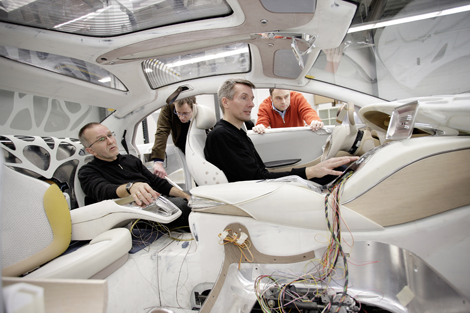
Image courtesy of Daimler AG
This is a big one for the European automotive industry, Daimler AG has selected Siemens NX as its standard for worldwide vehicle development.
Starting in the summer of 2012, Daimler will integrate work from over 20 development centres and their most important suppliers on a single product development platform. Unfortunately, both companies have agreed not to disclose the contract value.
While there were a few scant details available, it seems that the company has taken integration between it’s own Teamcenter-based Smaragd (meaning a green coloured gemstone) PLM system as a priority and looking to fully connect the two disciples of 3D design and lifecycle management. With the Daimler brand now covering Mercedes, Smart, AMG and several more in the passenger automotive world and both Mercedes and Freightliner trucks, this has huge implications for the supply chain across europe and beyond.
According to the release, based on the combination of NX and Teamcenter, Damiler “will establish digital collaboration from initial concept design, through simulation during design, down to proof of concept of design solutions. The consolidation of digital product information in one single worldwide data pool will facilitate new vehicle development. The introduction of parallel processes in development, design, production planning and production will further optimize the entire value chain. The combination of NX CAD software with our product data management system Smaragd, which is based on Teamcenter, will integrate our entire product creation process from design through production planning down to managing production machines,” said Prof. Bharat Balasubramanian, who is responsible at Daimler for R&D product innovation and process technology.
Dassault followed the announcement with a rather odd press release entitiled “Dassault Systèmes Informed of Daimler CAD Decision“. Part of a regulatory requirement, the press release announced that DS has been “informed today by Daimler A.G of its decision to select CAD from Siemens.” The release then when onto state that the decision came as a surprise to Dassault Systèmes as no Catia V6 evaluation has been performed by Daimler A.G. The company was “informed by Daimler A.G. that, as CAD application portfolio was not its priority, its decision was based upon CAD integration in its home grown PDM system “Smaragd”.”
The release then went onto point, with a slightly bitter tinge in the air, that V6 openness to other PDM systems is part of PLM V6R2011x, which was announced yesterday – obviously coming too late to be of much interest to Daimler. DS also went onto say that the company recently (September of 2010) renewed it’s contract for Catia until 2015 and will also be using Delmia, Enovia, Simulia, and 3DVIA tools, but it has which “Catia specialized applications would be replaced and which ones will have to remain in use.”

Image courtesy of Daimler AG
The automotive world is one that’s in an interesting spot. Environmental pressures means that the development of alternative fuel vehicles is ramping up and if they’re not careful many of today’s leading brands will find themselves in a sticky spot.
Already, todays vehicles are dramatically different from those of 20 years ago. The proliferation of electronics and computer controlled sub-system is huge and the rise of alternative power technologies will further compound that. Damiler is one of the most intriguing as it’s span of products starts at the very small with the Smart brand vehicles (that are likely to lead the electric or hybrid vehicle charge through the world of Mercedes) into performance cars with the likes of AMG and of course, commercial transportation faces many of the same issues.
While I’m no expert on the subject, the automotive world is one that’s going to, if not already, face huge complexity. Now you not only have the complexity of platform sharing across not only products and brands, there’s an increasing drive for more variants based on that same platform (Mercedes is known for having a massive range of options in its vehicles already).
Things are going to be further compounded by the introduction of new drive and power-train technologies. To handle that complexity and variation, you’re always going to need to look at the management of the process as a key priority and if your design tools fit into it, come with native capabilities to find and reuse data, then it’s going to be a much more preferable choice to source both 3D design and life cycle management from the same supplier.






